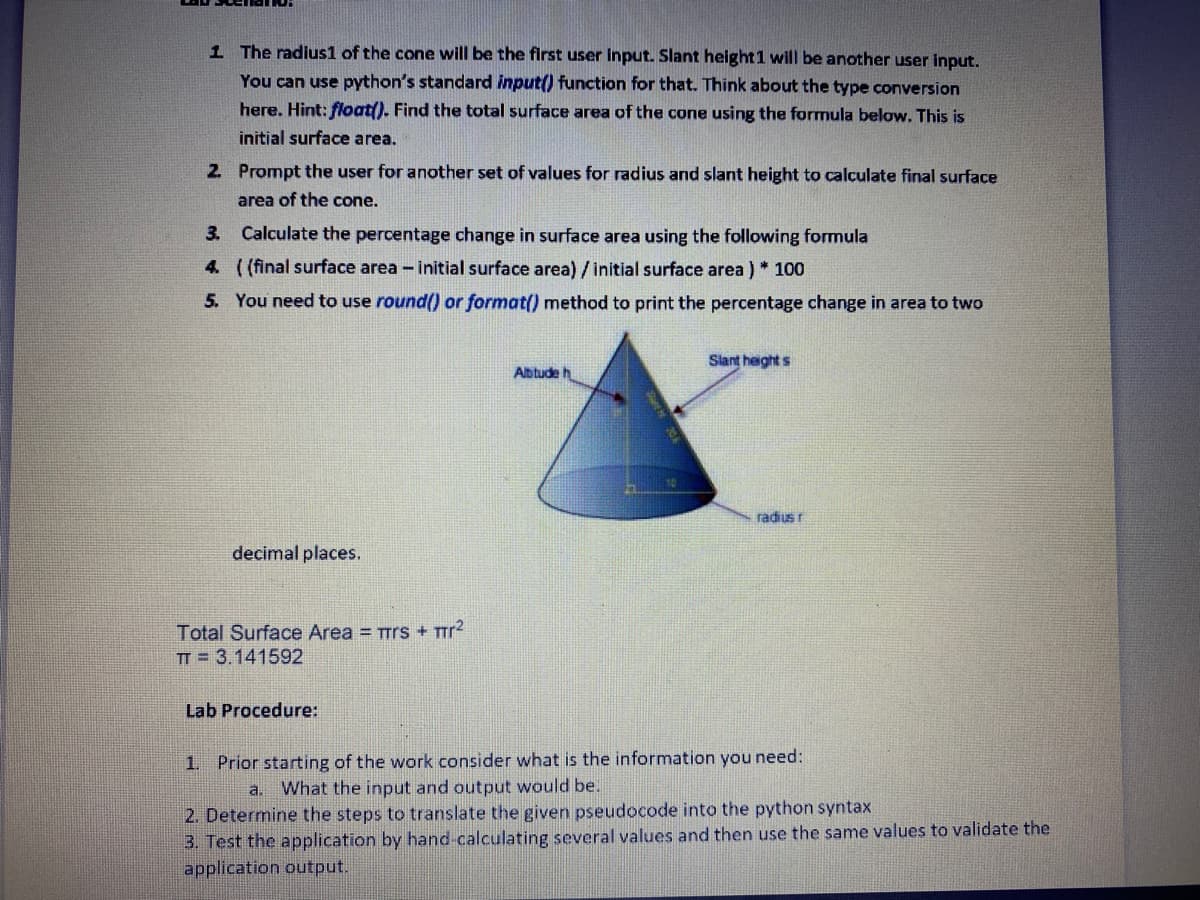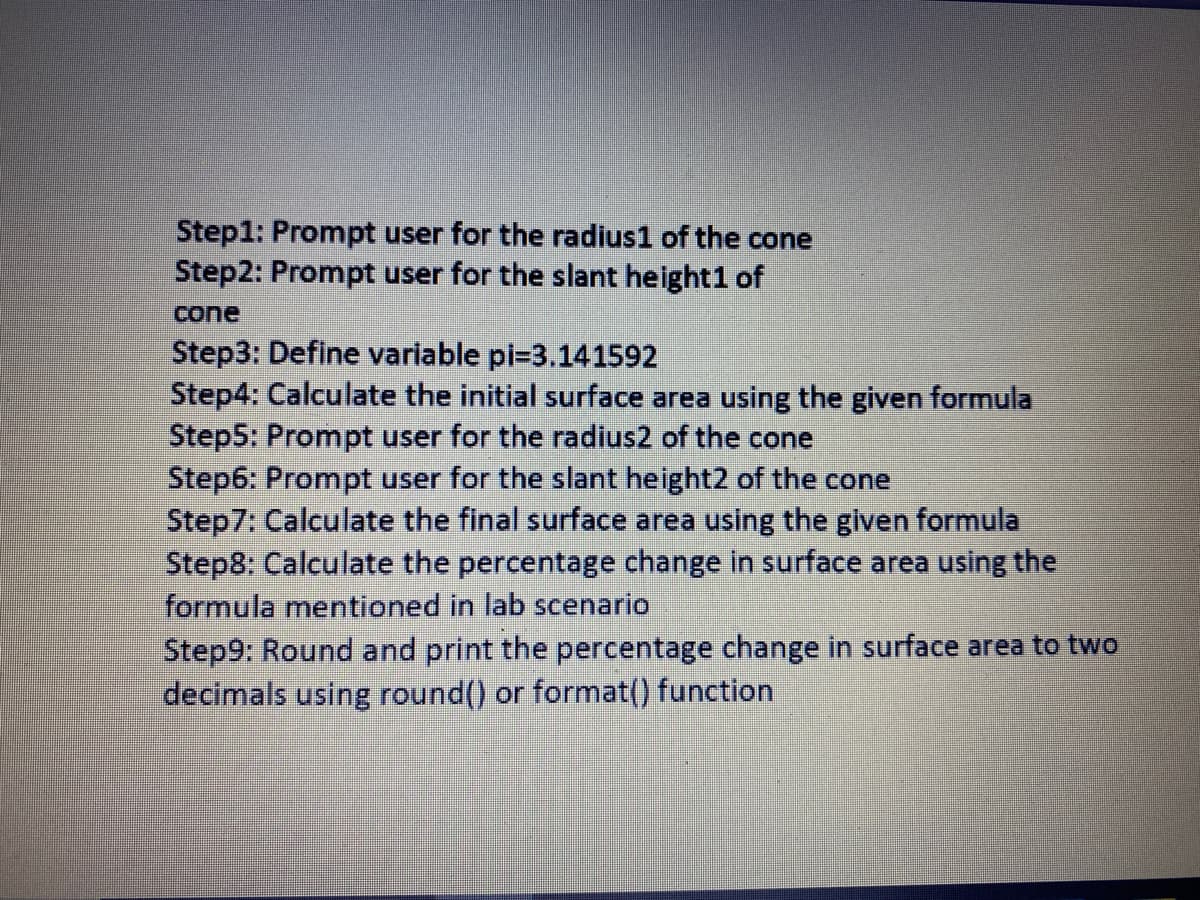1 The radius1 of the cone will be the first user input. Slant height 1 will be another user input. You can use python's standard input() function for that. Think about the type conversion here. Hint: float(). Find the total surface area of the cone using the formula below. This is initial surface area. 2. Prompt the user for another set of values for radius and slant height to calculate final surface area of the cone. 3. Calculate the percentage change in surface area using the following formula 4. ((final surface area - initial surface area) / initial surface area )* 100 5. You need to use round() or format() method to print the percentage change in area to two
1 The radius1 of the cone will be the first user input. Slant height 1 will be another user input. You can use python's standard input() function for that. Think about the type conversion here. Hint: float(). Find the total surface area of the cone using the formula below. This is initial surface area. 2. Prompt the user for another set of values for radius and slant height to calculate final surface area of the cone. 3. Calculate the percentage change in surface area using the following formula 4. ((final surface area - initial surface area) / initial surface area )* 100 5. You need to use round() or format() method to print the percentage change in area to two
Computer Networking: A Top-Down Approach (7th Edition)
7th Edition
ISBN:9780133594140
Author:James Kurose, Keith Ross
Publisher:James Kurose, Keith Ross
Chapter1: Computer Networks And The Internet
Section: Chapter Questions
Problem R1RQ: What is the difference between a host and an end system? List several different types of end...
Related questions
Question
100%
Please help me solving this question

Transcribed Image Text:1 The radius1 of the cone will be the first user input. Slant height1 will be another user input.
You can use python's standard input() function for that. Think about the type conversion
here. Hint: float(). Find the total surface area of the cone using the formula below. This is
initial surface area.
2 Prompt the user for another set of values for radius and slant height to calculate final surface
area of the cone.
3. Calculate the percentage change in surface area using the following formula
4. ((final surface area - initial surface area) / initial surface area ) * 100
5. You need to use round() or format() method to print the percentage change in area to two
Slant height s
Albtude h
radius
decimal places.
Total Surface Area = TTrs + Tr?
TT = 3.141592
Lab Procedure:
1. Prior starting of the work consider what is the information you need:
a. What the input and output would be.
2. Determine the steps to translate the given pseudocode into the python syntax
3. Test the application by hand-calculating several values and then use the same values to validate the
application output.

Transcribed Image Text:Step1: Prompt user for the radius1 of the cone
Step2: Prompt user for the slant height1 of
cone
Step3: Define variable pi=3.141592
Step4: Calculate the initial surface area using the given formula
Step5: Prompt user for the radius2 of the cone
Step6: Prompt user for the slant height2 of the cone
Step7: Calculate the final surface area using the glven formula
Step8: Calculate the percentage change in surface area using the
formula mentioned in lab scenario
Step9: Round and print the percentage change in surface area to two
decimals using round() or format() function
Expert Solution
This question has been solved!
Explore an expertly crafted, step-by-step solution for a thorough understanding of key concepts.
This is a popular solution!
Trending now
This is a popular solution!
Step by step
Solved in 2 steps with 2 images

Recommended textbooks for you

Computer Networking: A Top-Down Approach (7th Edi…
Computer Engineering
ISBN:
9780133594140
Author:
James Kurose, Keith Ross
Publisher:
PEARSON

Computer Organization and Design MIPS Edition, Fi…
Computer Engineering
ISBN:
9780124077263
Author:
David A. Patterson, John L. Hennessy
Publisher:
Elsevier Science

Network+ Guide to Networks (MindTap Course List)
Computer Engineering
ISBN:
9781337569330
Author:
Jill West, Tamara Dean, Jean Andrews
Publisher:
Cengage Learning

Computer Networking: A Top-Down Approach (7th Edi…
Computer Engineering
ISBN:
9780133594140
Author:
James Kurose, Keith Ross
Publisher:
PEARSON

Computer Organization and Design MIPS Edition, Fi…
Computer Engineering
ISBN:
9780124077263
Author:
David A. Patterson, John L. Hennessy
Publisher:
Elsevier Science

Network+ Guide to Networks (MindTap Course List)
Computer Engineering
ISBN:
9781337569330
Author:
Jill West, Tamara Dean, Jean Andrews
Publisher:
Cengage Learning

Concepts of Database Management
Computer Engineering
ISBN:
9781337093422
Author:
Joy L. Starks, Philip J. Pratt, Mary Z. Last
Publisher:
Cengage Learning

Prelude to Programming
Computer Engineering
ISBN:
9780133750423
Author:
VENIT, Stewart
Publisher:
Pearson Education

Sc Business Data Communications and Networking, T…
Computer Engineering
ISBN:
9781119368830
Author:
FITZGERALD
Publisher:
WILEY